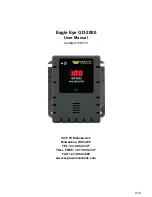
- 21 - 325.6610.17
3.2.2.3 Receiver Outputs
The outputs of the receiver fall into two categories
•
Analog - gas concentration data as a linear current output
•
Digital - relay contact-closure
3.2.2.3.1
Analog Outputs (AO)
An optional 4-20 mA or 0-20 mA analog output linearly proportional to sensed gas
concentration is available on terminal block TB1 for each sensor channel. The
analog output specifications are given below:
Feature
Specification
Max.
Number
4
Rated Signal Range
0-20 mA or 4-20 mA
Control
Range
0-21.5
mA
No-Load
Voltage
to
24
V
Load
Range
900
ohms
Filter
Time
Constant
50
ms
Output Measurement Error
< +/- 0.02 mA
Temperature Coefficient
< +/-0.02 mA/°C
The analog outputs are not isolated since they all share the same “circuit common”
return point (Refer to Figure 2-4).
3.2.2.3.2
Digital Outputs (DO)
Three SPDT relay outputs are standard on the Chloralert Plus main circuit board.
Access to normally open (NO) and normally closed (NC) contacts is provided via
terminal block TB2.
A circuit board with an additional six output relays with SPST normally open (NO)
contact arrangement is available as an option to provide additional alarm functionally,
if desired. Contact outputs are available on TB1.
The inputs that control the digital output (DO) relays are selected by the operator using
the receiver’s
SETUP-CONFIGURATION-DIGITAL OUTPUTS
mode (Refer to section
4.4.2.3). The Chloralert™ Plus is able to be configured by the customer to allow control
of all DO’s by a single input or to allow each DO to be controlled by a different input.
The operator should maintain a listing of the functions assigned to each digital output.
The need for separate relays for each channel depends on the device connected to the
relay and the location of the various sensor/transmitters. If each of these is mounted
remotely in different locations then each channel requires dedicated relays to alert
attending personnel of a gas release.
The normal/delayed option allows the operator to cope with output surges that are due
to electrical pickup rather than a genuine gas exposure. This mode is only important
whenever the alarm is set to instantaneous concentration, not TWA or STEL. This alarm
delay may be used to eliminate alarms during power-up (refer to section 4.3), thereby
eliminating false alarms.
3.2.2.4
Keypad Push-button
The keypad contains a total of 20 push-button arranged in a 4-row x 5-column
matrix. The keypad layout is shown in Figure 3-1.
Summary of Contents for Capital Controls CHLORALERT 17CA3000 Series
Page 14: ...325 6610 17 14 Figure 2 1 Receiver Outline Dimensions ...
Page 15: ... 15 325 6610 17 Figure 2 2 Sensor Transmitter Outline Dimensions ...
Page 16: ...325 6610 17 16 Figure 2 3 Interconnection Diagram ...
Page 18: ...325 6610 17 18 Figure 2 4 Sensor Wiring ...
Page 44: ...325 6610 17 44 ...
















































